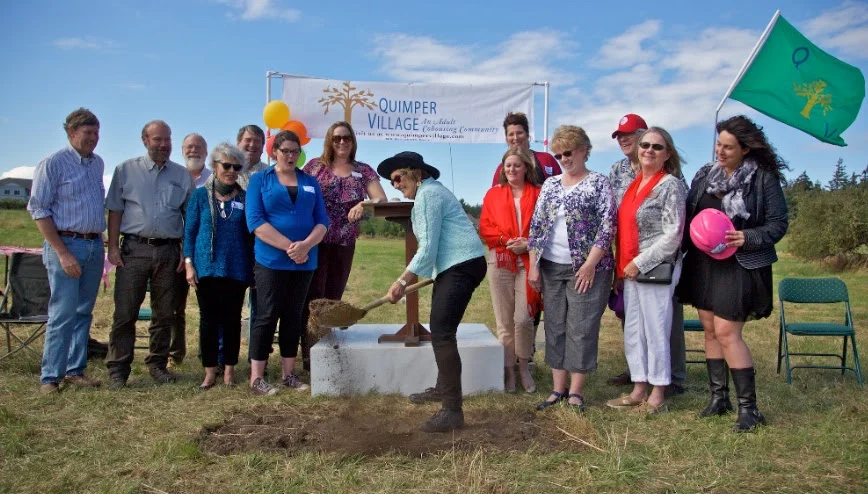Traditional cohousing
Durrett, whose firm McCamant and Durrett Architects focuses on cohousing, lives in Nevada City, California.
He brought the concept of cohousing from Europe to North America decades ago. In 1988, Durrett and Kathryn McCamant introduced the idea through the book Cohousing: A Contemporary Approach to Housing Ourselves. More recently, they published Creating Cohousing: Building Sustainable Communities.
Cohousing, Durrett explained, originated in Denmark where it’s called “Bofaelleskaber.”
“I didn’t think Bofaelleskaber was going to work well in the USA,” he said. “One day, when I was living in Denmark, the Danish government called me up and said, ‘Chuck, we’re translating an article about Bofaelleskaber tomorrow, so we need a word tomorrow’ so I spent the evening coming up with a word.”
He’s lived in three cohousing communities over the past 25 years and has been involved in helping build 55, including five in Canada. Among them is Vancouver Cohousing on East 33rd Avenue, which includes 6,200 square feet of shared space — a size that’s nearly impossible to re-produce in Vancouver these days given the high price of land.
Durrett was involved in several workshops with members of Vancouver Cohousing from which all the preliminary designs were produced. They were then handed over to a local architect who did the working drawings.
During the workshops, numerous details, such as reducing the number of parking places, were nailed down.
Durrett maintains the design details that are developed and the relationships that are formed through a hands-on process with the entire cohousing group helps create the foundation for, and the culture for, how the complex will function once everyone moves in. That includes how residents get along and how much time is spent in shared spaces, especially after the honeymoon phase wears off.
“My cohousing community has about 450 people-hours a week and I’m sure it’s pretty similar in Vancouver Cohousing because it was a very hands-on design,” he said. “Even a badly designed cohousing has about 100 people-hours and in non-cohousing [development] it’s 50 people hours a week,” he said.
The night before speaking to the Courier, Durrett said his cohousing complex held a dinner with about 50 members in attendance, followed by a game night and music in the common house, after which people played pool until midnight.
“There’s a real heartbeat there and it’s partially because all these people knew each other quite well when they moved in. They’re a community when they move in. That’s the big difference — what participation brings to the table. One of the many big differences,” he said.
Durrett doesn’t believe a design committee is as effective. He also suspects it would take longer because of the back-and-forth.
“It just adds another step — the notion you’re going to take the whole group’s concerns, give it to a design committee and they’re going to translate it. Because when they translate it, they’re going to have forgotten some stuff. Anyway, I’m very curious to see how it turns out,” he said.
Durrett also thinks the idea comes from a place of mistrust based on a perception that involving everyone will make the process too long.
“It never works for some people in the group to think that they’re protecting the interests of others in the group. Every time that happens, it makes everything a lot more conservative…,” he said.
"Basically, you’re precluding possibilities. … You never know where the good ideas are going to come from. I can tell you, because I've designed 55 cohousing now, that that meek and mild, quiet voice in the corner, who never says anything, sometimes comes up with a watershed [idea]. They would never, ever be on the design committee because [they think they] don’t have enough confidence or [they're] not that hip to design and these other guys have been reading all the magazines and they know enough to be dangerous. But the reality is there are a lot of quiet voices that bring a lot of wisdom to the table — real values, real experiences and I want to hear from them. They get things done.”
The future
Despite his reservations, Durrett said he hopes “for the best” for cohousing lite, although he wondered how success would be measured.
In fact, Our Urban Village and the developer plan to continue their relationship beyond build-out. They’re working with the organization Happy City, led by Charles Montgomery who wrote the 2013 book Happy City, Transforming Our Lives Through Urban Design. Happy City will track how the community functions for a couple years after move-in, including interviewing members and conducting focus groups to see what’s working, what’s not working and what can be tweaked.
Durrett, meanwhile, remains concerned about how the project evolved.
“If they’re hands off, they’re not going to get what they want. The way to mold the clay is to have your hand on the clay. So we’ll see if they’re happy, semi-happy, unhappy… it’s going to be somewhere along there,” he said.












